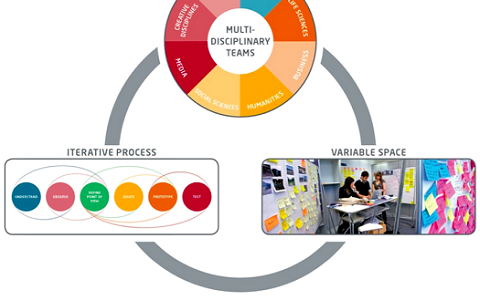
Design Thinking – People • Project • Space
The Potsdam HPI was founded with a focus on IT systems engineering, but in 2007 Professor Ulrich Weinberg, a CGI expert who had spent time at the Stanford d.school was brought in to start a School of Design Thinking in Potsdam too, building on the success of the Stanford original.
Uli Weinberg, in a conversation with IEDP, clarified that “the School of Design Thinking is not a ‘design school’ – it just uses the way designers think to help collaboration”. In order to tackle complex problems it is necessary to bring together different perspectives. The d.schools do this; bringing medics, biologists, engineers, programmers and many others together to explore issues from their various points of view so that they can fully understand each issue’s aspects and nuances.
Weinberg continues “at high school and university we are trained to be in ‘single person competitive mode’, where we are graded and benchmark our performance against our fellow students… who is up and who is down? In the twenty-first century the need is to be in ‘co-operative, networked mode’. With business’s rising complexity the pressure to change is constant and increasing.” In the analogue era we had time to deal with complexity, but in the digital era the velocity is much greater and individuals do not have the capacity, or bandwidth, to handle both the speed of change and its complexity.

Architects typically work by researching their clients’ needs, talking to people about how they live/work for the relevant building, explore the technical issues, map behaviours, and understand how sustainability can be built in. This is an iterative process until they feel they are nearing a satisfactory solution. Then they will build prototype models, to further comprehend how the building will work in practice.
Imagine an architect or designers office – it stereotypically looks and feels very different from one you would imagine for a lawyer, accountant or even marketing manager.
Weinberg explains that these three elements – people, the need to work in diverse and collaborative teams; project – the non-linear methodology of designers; and place – the physical space that supports teamwork and creativity, are the foundational elements of design thinking.
One of the keys to design thinking is keeping the teams focused on real problems. At the d.school students select challenges that come from real-world organizations, and work with other students who have selected the same projects, to create solutions through this collaborative and iterative process. Weinberg cites several successful products and services that have been evolved by Potsdam d.school students, from a service to improve health care in rural South Africa (http://www.summo.org/) to a vacuum cleaner company (http://www.crooser.de/thomas/), a new laundry washing experience and improved airport security.
Weinberg recently spent time with Rupert Stadler, Chairman of Audi, discussing the role of the car in the future. How it is placed to move beyond a means of transport and towards providing users with additional time – today’s most precious resource. Watch the conversation here (http://www.audi-reports.com/ar2014/stories/the-crystal-gazers/).
The d.school also develops cohorts from the corporate world, with participants from the likes of Siemens, Deutsche Bank, Deutsche Telekom and Bayer all having experienced custom workshops. Weinberg sees that the ‘People-Project-Place’ approach is applicable in all contexts, to enhance teamwork and foster greater innovation, it lies at the core of effective work and learning – and is creating new products and processes for organizations across the globe.
Prof Uli Weinberg will be discussing the importance of Collaboration, innovation processes and physical space at Corporate Learning Circle’s 1st International Conference on Innovation in Berlin in June.
(published with permission of iedp)